|
Battle of Cold Harbor
Cold Harbor May 31 - June 12, 1864
| Dead Soldiers' Remains at Cold Harbor Battlefield |
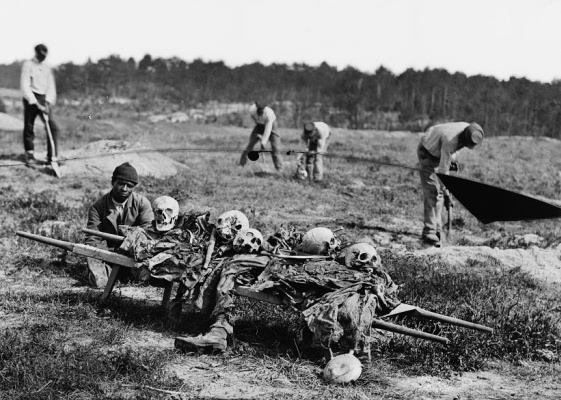
|
| Battle of Cold Harbor, Library of Congress |
(Right) While entrenching and preparing for the Battle of Cold Harbor, aka 2nd
Battle of Cold Harbor, Union soldiers discovered skeletal remains from the location's first
battle.
Introduction: Following the Union disaster at the Battle
of Cold Harbor, General Ulysses S. Grant said, "I regret this assault more than any one I ever ordered." And Grant had ordered many assaults.
The Battle of Cold Harbor was one of the final battles of Union Lt.
Gen. Ulysses S. Grant's 1864 Overland Campaign during
the American Civil War (1861-65) and is remembered as one of American history's bloodiest, most lopsided battles. In
a desperate attempt to dislodge the troops of Confederate General Robert E. Lee, Grant pushed his soldiers into
well-entrenched enemy positions at Cold Harbor. As a result, thousands of Union soldiers were killed or wounded during the
series of suicidal frontal assaults against the fortified Confederate positions. Grant also said of the battle
in his memoirs "I have always regretted that the last assault at Cold Harbor
was ever made. I might say the same thing of the assault of the 22d of May, 1863, at Vicksburg. At Cold Harbor no advantage
whatever was gained to compensate for the heavy loss we sustained." The fight at Cold Harbor had witnessed Union persistence
against Confederate resolve. Next, Lee's army would slosh toward Richmond, where Grant's reinforced army would finally
gain the upper hand.
Summary: The Battle of
Cold Harbor was fought May 31 to June 12, 1864,
in central Virginia over the same ground as the Battle of Gaines Mill during the Seven Days
Battles of 1862. In fact, some accounts refer to the 1862 engagement as the First Battle
of Cold Harbor while the 1864 fight is known as the Second Battle of Cold Harbor. Despite its name, Cold Harbor was not
a port city. It described two rural crossroads named for a hotel located in the area (Cold Harbor Tavern, owned by the Isaac
Burnett family), which provided shelter (harbor) but not hot meals. Old Cold Harbor stood two miles east of Gaines Mill, New
Cold Harbor a mile southeast. Both were approximately 10 miles northeast of the Confederate capital of Richmond.
The Union army of nearly 110,000 strong would press Lee's 60,000 Confederates
on May 31, 1864, as Sheridan’s cavalry moved and seized the vital crossroads of Old Cold Harbor. Early on June
1, relying heavily on their new repeating carbines and shallow entrenchments, Sheridan’s troopers threw back an attack
by Confederate infantry. Confederate reinforcements arrived from Richmond and from the Totopotomoy Creek lines. Late on June
1, the Union VI and XVIII Corps reached Cold Harbor and assaulted the Confederate works with some success. By June 2, both
armies were on the field, forming on a seven-mile front that extended from Bethesda Church to the Chickahominy River. At dawn
June 3, the II and XVIII Corps, followed later by the IX Corps, assaulted along the Bethesda Church-Cold Harbor line and were
slaughtered at all points. Grant commented in his memoirs that this was the only attack he wished he had never ordered. The
armies confronted each other on these lines until the night of June 12, when Grant again advanced by his left flank, marching
to James River. On June 14, the II Corps was ferried across the river at Wilcox’s Landing by transports. On June 15,
the rest of the army began crossing on a 2,200-foot long pontoon bridge at Weyanoke. Abandoning the well-defended approaches
to Richmond, Grant sought to shift his army quickly south of the river to threaten Petersburg. Cold Harbor was also approximately
10 miles northeast of the Confederate capital of Richmond, making it a vital and strategic location. The Union army had
lost some 13,000 men over the twelve day fiasco, while Lee sustained just 2,500 casualties. Known as Grant the Butcher,
the Union commander vowed to never repeat the mistakes of Cold Harbor.
| Richmond National Battlefield Park |
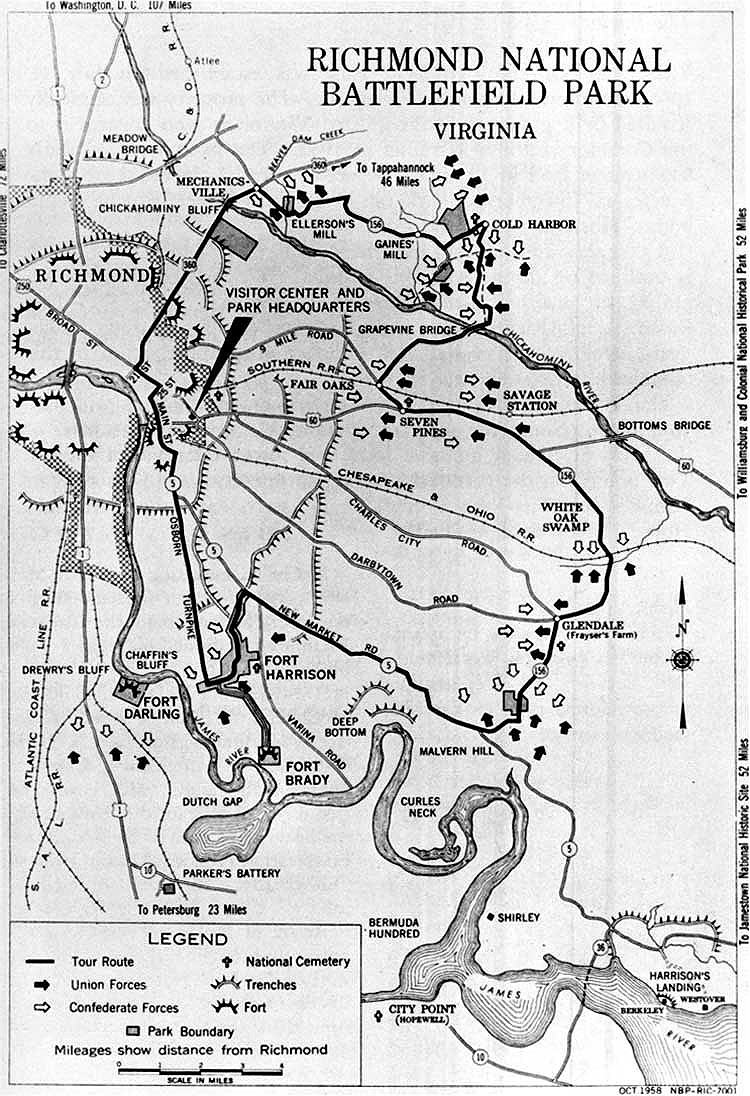
|
| Battle of Cold Harbor Location |
Background: Grant's Overland Campaign was one of a series of
simultaneous offensives the newly appointed Union general in chief launched against the Confederacy. By late May 1864, only
two of these continued to advance: Maj. Gen. William T. Sherman's Atlanta Campaign and the Overland Campaign, in which Lt.
Gen. Ulysses S. Grant accompanied and directly supervised the Army of the Potomac and its commander, Maj. Gen. George
G. Meade. Grant's campaign objective was not the Confederate capital of Richmond, but the destruction of Lee's army. President
Abraham Lincoln had long advocated this strategy for his generals, recognizing that the city would certainly fall after the
loss of its principal defensive army. Grant ordered Meade, "Wherever Lee goes, there you will go also." Although he hoped
for a quick, decisive battle, Grant was prepared to fight a war of attrition. Both Union and Confederate casualties could
be high, but the Union had greater resources to replace lost soldiers and equipment.
On May 5, after Grant's army crossed the Rapidan River and entered the Wilderness
of Spotsylvania, it was attacked by Lee's Army of Northern Virginia. Although Gen. Robert E. Lee was outnumbered, about 60,000
to 110,000, his men fought fiercely and the dense foliage provided a terrain advantage.
After two days of intense fighting and almost 29,000 casualties, the results were inconclusive and neither army was able to
obtain an advantage. Lee had stopped Grant, but had not turned him back; Grant had not destroyed Lee's army. Under similar
circumstances, previous Union commanders had chosen to withdraw behind the Rappahannock, but Grant instead ordered Meade to
move around Lee's right flank and seize the important crossroads at Spotsylvania Court House to the southeast, hoping
that by interposing his army between Lee and Richmond, he could lure the Confederates into another battle on a more favorable
field.
(Right) Map shows the numerous battles fought around Richmond, the trenches,
forts, Union and Confederate troop movements, and the mileage or distance from Richmond. Richmond National Battlefield
Park, 1958.
Elements of Lee's army beat the Union army to the critical crossroads of
Spotsylvania Court House and began entrenching, a tactic that became increasingly essential for the outnumbered defenders.
Meade was dissatisfied with Maj. Gen. Philip Sheridan's Union cavalry's performance and released it from its reconnaissance
and screening duties for the main body of the army to pursue and defeat the Confederate cavalry under Maj. Gen. J.E.B. Stuart.
Sheridan's men mortally wounded Stuart in the tactically inconclusive Battle of Yellow Tavern (May 11) and then continued
their raid toward Richmond, leaving Grant and Meade without the "eyes and ears" of their cavalry.
Near Spotsylvania Court House, fighting occurred on and off from May 8 through
May 21, as Grant tried various schemes to break the Confederate line. On May 8, Union Maj. Gens. Gouverneur K. Warren and
John Sedgwick unsuccessfully attempted to dislodge the Rebels under Maj. Gen. Richard H. Anderson from Laurel Hill, a position
that was blocking them from Spotsylvania Court House. On May 10, Grant ordered attacks across the Confederate line of earthworks,
which by now extended over 4 miles, including a prominent salient known as the Mule Shoe. Although the Union troops failed
again at Laurel Hill, an innovative assault attempt by Col. Emory Upton against the Mule Shoe showed promise.
Grant used Upton's assault technique on a much larger scale on May 12 when
he ordered the 15,000 men of Maj. Gen. Winfield Scott Hancock's corps to assault the Mule Shoe. Hancock was initially successful,
but the Confederate leadership rallied and repulsed his incursion. Attacks by Maj. Gen. Horatio G. Wright on the western edge
of the Mule Shoe, which became known as the Bloody Angle, involved almost 24 hours of desperate hand-to-hand fighting,
some of the most intense of the Civil War. Supporting attacks by Warren and by Maj. Gen. Ambrose Burnside were unsuccessful.
In the end, the battle was tactically inconclusive, but with almost 32,000 casualties on both sides, it was the costliest
battle of the campaign. Grant planned to end the stalemate by once again shifting around Lee's right flank to the southeast,
toward Richmond.
Grant's objective following Spotsylvania was the North Anna River, about
25 miles south. He sent Hancock's Corps ahead of his army, hoping that Lee would attack it, luring him into the open. Lee
did not take the bait and beat Grant to the North Anna. On May 23, Warren's V Corps crossed the river at Jericho Mills, fighting
off an attack by A.P. Hill's corps, while Hancock's II Corps captured the bridge on the Telegraph Road. Lee then devised an
ingenious plan, which represented a significant potential threat to Grant: a five-mile line that formed an inverted "V" shape
with its apex on the river at Ox Ford, the only defensible crossing in the area. By moving south of the river, Lee hoped that
Grant would assume that he was retreating, leaving only a token force to prevent a crossing at Ox Ford. If Grant pursued,
the pointed wedge of the inverted V would split his army and Lee could concentrate on interior lines to defeat one wing; the
other Union wing would have to cross the North Anna twice to support the attacked wing.
Grant almost fell into Lee's trap. He assaulted the tip of the apex at Ox
Ford and the right wing of the V, but Lee, who was incapacitated in his tent by diarrhea, could not coordinate the attack
he planned to make, losing a golden opportunity. Grant finally realized the situation he faced with a divided army and ordered
his men to stop advancing and to build earthworks of their own. However, the Union general remained optimistic. He was convinced
that Lee had demonstrated the weakness of his army by not attacking when he had the upper hand. He wrote to the Army's chief
of staff, Maj. Gen. Henry W. Halleck: "Lee's army is really whipped. ... I may be mistaken but I feel that our success over
Lee's army is already assured."
| Cold Harbor Battlefields |
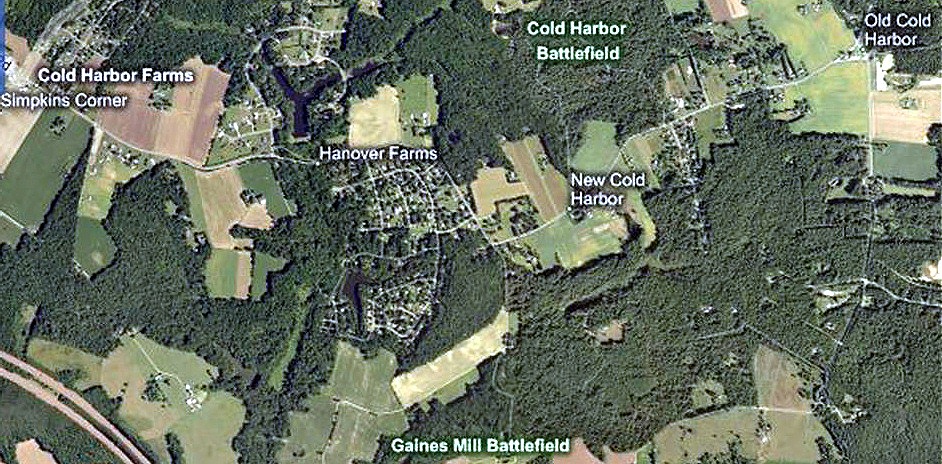
|
| Cold Harbor Map Courtesy Microsoft Virtual Earth |
(About) Satellite photograph showing Cold Harbor and Gaines Mill battlefields, as well
as both Old and New Cold Harbors. Courtesy Microsoft Virtual Earth.
As he did after the Wilderness and Spotsylvania, Grant planned another wide
swing around Lee's flank, marching east of the Pamunkey River to screen his movements from the Confederates. His army disengaged
on May 27 and crossed the river. Lee moved his army swiftly in response, heading for Atlee's Station on the Virginia Central
Railroad, a point only 9 miles north of Richmond. There, his men would be well-positioned behind a stream known as Totopotomoy
Creek to defend against Grant if he moved against the railroads or Richmond. Lee was not certain of Grant's specific plans,
however; if Grant was not intending to cross the Pamunkey in force at Hanovertown, the Union army could outflank him and head
directly to Richmond. Lee ordered cavalry under Maj. Gen. Wade Hampton to make a reconnaissance in force, break through the
Union cavalry screen, and find the Union infantry.
On May 28, Hampton's troopers encountered Union cavalry under Brig. Gen.
David McM. Gregg in the Battle of Haw's Shop. Fighting predominately dismounted and utilizing earthworks for protection, neither
side achieved an advantage. The battle was inconclusive, but it was one of the bloodiest cavalry engagements of the war. Hampton
held up the Union cavalry for seven hours, prevented it from achieving its reconnaissance objectives, and had provided valuable
intelligence to Lee about the disposition of Grant's army.
After Grant's infantry had crossed to the south bank of the Pamunkey, Lee
saw an opportunity on May 30 to attack Warren's advancing V Corps with his Second Corps, now commanded by Lt. Gen. Jubal Early.
Early's divisions under Maj. Gens. Robert E. Rodes and Stephen Dodson Ramseur drove the Union troops back in the Battle of
Bethesda Church, but Ramseur's advance was stopped by a fierce stand of infantry and artillery fire. On that same day, a small
cavalry engagement at Matadequin Creek (the Battle of Old Church) drove an outnumbered Confederate cavalry brigade to the
crossroads of Old Cold Harbor, verifying to Lee that Grant intended to move toward that vital intersection beyond Lee's right
flank, attempting to avoid another stalemate on the Totopotomoy Creek line.
Lee received notice that reinforcements were heading Grant's way from Bermuda
Hundred. The 16,000 men of Maj. Gen. William F. "Baldy" Smith's XVIII Corps were withdrawn from Maj. Gen. Benjamin Butler's
Army of the James at Grant's request, and they were moving down the James River and up the York to the Pamunkey. If Smith
moved due west from White House Landing to Old Cold Harbor, 3 miles southeast of Bethesda Church and Grant's left flank, the
extended Federal line would be too far south for the Confederate right to contain. Smith's men arrived at White House May
30–31. One brigade was left behind on guard duty, but about 10,000 men arrived to join Grant's army about 3 p.m. on
June 1.
| Cold Harbor Battlefield, June 1 |
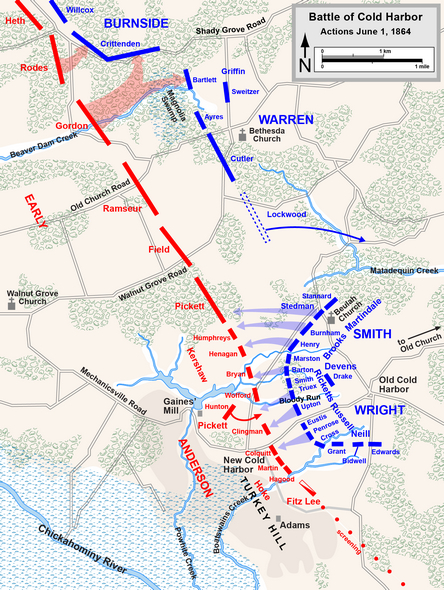
|
| Battle of Cold Harbor, June 1, 1864 |
| 1864 Virginia Civil War Battlefields |
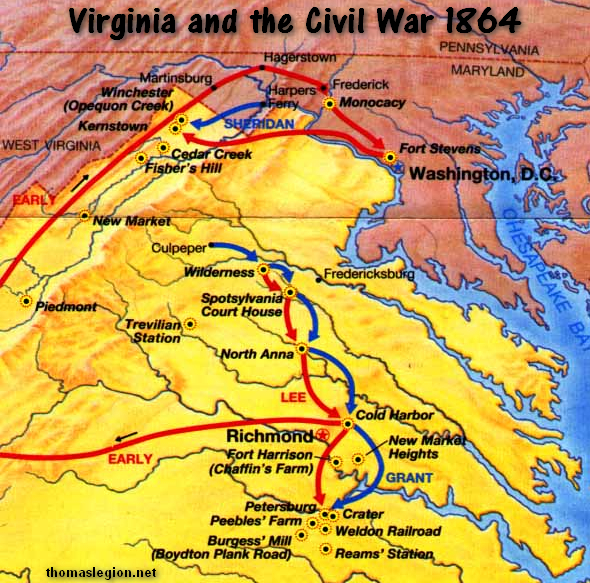
|
| Virginia and the Civil War in 1864 |
Lee also received reinforcements. Confederate President Jefferson
Davis directed Gen. P.G.T. Beauregard to send the division of Maj. Gen. Robert F. Hoke, over 7,000 men, from below the James
River. (The first troops of Hoke's division arrived at Old Cold Harbor on May 31, but were unable to prevent the Union cavalry
from seizing the intersection.) With these additional troops, and by managing to replace many of his 20,000 casualties to
that point in the campaign, Lee's Army of Northern Virginia had some 58,000 men to contend with Meade's and Grant's 108,000.
But the disparity in numbers was no longer what it had been—Grant's reinforcements were often raw recruits and heavy
artillery troops, pulled from the defenses of Washington, D.C., who were relatively inexperienced in infantry tactics, while
most of Lee's had been veterans moved from inactive fronts, and who were soon entrenched in impressive fortifications.
History: In the Overland Campaign of 1864, Lt.
Gen. Grant with the Army of the Potomac battled Gen. Robert E. Lee and the Army of Northern Virginia for six weeks across central Virginia. At the Wilderness, Spotsylvania, North Anna and Totopotomoy Creek,
Lee repeatedly stalled, but failed to stop, Grant's southward progress toward the Confederate capital of Richmond. The next
logical military objective for Grant was the crossroads styled by locals as Old Cold Harbor. The Battle of Cold Harbor was fought from May 31 to June 12, 1864, with the most significant
fighting occurring on June 3. It was one of the final battles of Union Lt. Gen. Ulysses S. Grant's Overland Campaign during
the Civil War, and is remembered as one of American history's bloodiest, most lopsided battles. Thousands of Union soldiers
were killed or wounded in a hopeless frontal assault against the fortified positions of Confederate Gen. Robert E. Lee's army.
On May 31, Lee sent a cavalry division under Maj. Gen. Fitzhugh Lee to reinforce
Butler and secure the crossroads at Old Cold Harbor and ordered Anderson's First Corps to shift right from Totopotomoy Creek
to support the cavalry. The lead brigade of Hoke's division also reached the crossroads to join Butler and Fitzhugh Lee. At
4 p.m. Torbert and elements of Brig. Gen. David McM. Gregg's cavalry division drove the Confederates from the Old Cold Harbor
crossroads and began to dig in. As more of Hoke's and Anderson's men arrived, Union cavalry commander Maj. Gen. Philip Sheridan
became concerned and ordered Torbert to pull back toward Old Church. Grant continued his interest in Old Cold Harbor as an
avenue for Smith's arrival and ordered Wright's VI Corps to move in that direction from his right flank on Totopotomoy Creek,
and he ordered Sheridan to return to the crossroads and secure it "at all hazards." Torbert returned at 1 a.m. and was relieved
to find that the Confederates had failed to notice his previous withdrawal.
Gen. Robert E. Lee's plan for June 1 was to use his newly concentrated infantry
against the small cavalry forces at Old Cold Harbor, but his subordinates did not coordinate correctly. Anderson did not integrate
Hoke's division with his attack plan and left him with the understanding that he was not to assault until the First Corps'
attack was well underway, because the Union defenders were disorganized as well. Wright's VI Corps had not moved out until
after midnight and was on a 15-mile march. Smith's XVIII Corps had mistakenly been sent to New Castle Ferry on the Pamunkey
River, several miles away, and did not reach Old Cold Harbor in time to assist Torbert.
| Battle of Cold Harbor |
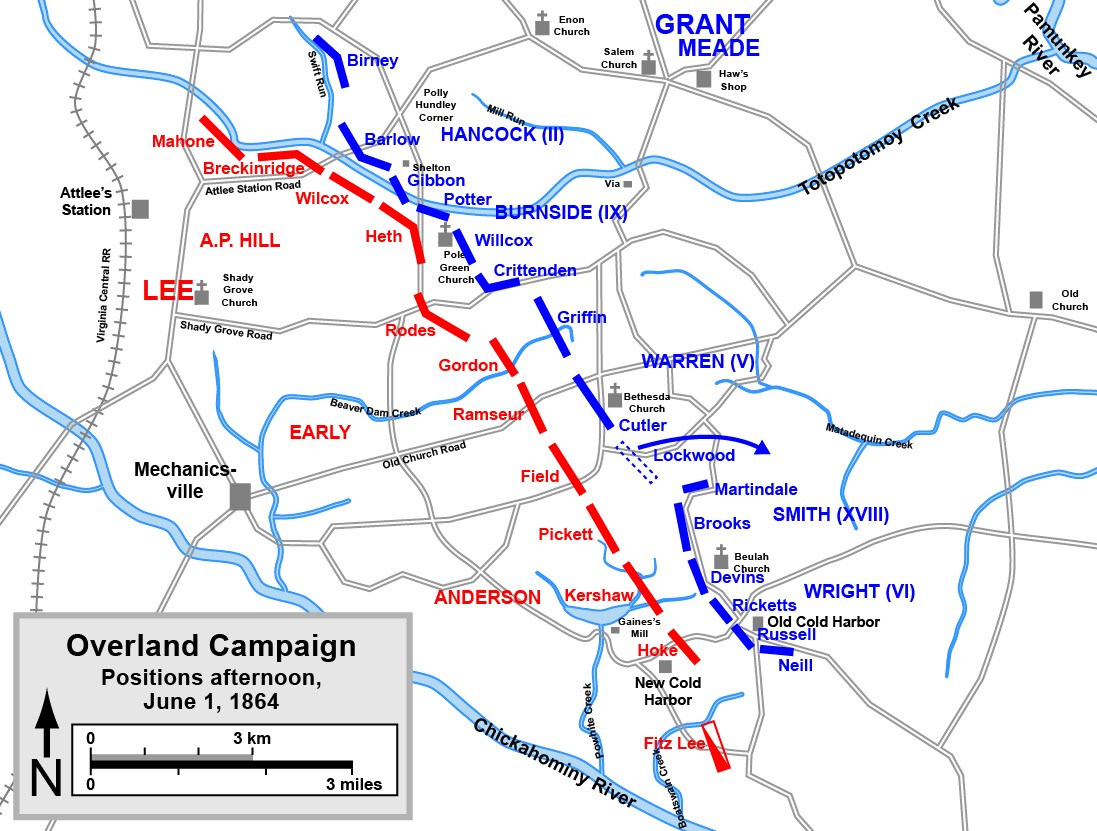
|
| Cold Harbor Battlefield, June 1, 1864 |
Anderson's attack was poorly coordinated and driven back by the heavy firepower
of the Union cavalry's Spencer repeating carbines. By 9 a.m. Wright's lead elements arrived at the crossroads, but Wright
decided to delay Grant's intended attack until after Smith arrived, which occurred in the afternoon, and the XVIII Corps men
began to entrench on the right of the VI Corps. At 6:30 p.m. the attack that Grant had ordered for the morning finally began.
Both Wright's and Smith's corps moved forward. Wright's men made little progress south of the Mechanicsville Road, recoiling
from heavy fire. North of the road, Brig. Gen. Emory Upton's brigade also met with heavy fire from Brig. Gen. Thomas L. Clingman's
brigade and fell back to its starting point. To Upton's right, the brigade of Col. William S. Truex found a gap in the Confederate
line through a swampy, brush-filled ravine. As Truex's men charged through the gap, Clingman swung two regiments around to
face them, and Anderson sent in Brig. Gen. Eppa Hunton's brigade from his corps reserve. Truex became surrounded on three
sides and was forced to withdraw.
While action continued on the
southern end of the battlefield, the three corps of Hancock, Burnside, and Warren were occupying a 5-mile line that stretched
southeast to Bethesda Church, facing the Confederates under A.P. Hill, Breckinridge, and Early. At the border between
the IX and V Corps, two divisions of Early's Corps—Maj. Gen. Robert E. Rodes on the left, Maj. Gen. John B. Gordon on
the right—attacked at 7 p.m. Warren later described this attack as a "feeler", and despite some initial successes, both
Confederate probes were repulsed.
Although the June 1 attacks had been unsuccessful, Meade believed that an
attack early on June 2 could succeed if he was able to mass sufficient forces against an appropriate location. He and Grant
decided to target Lee's right flank. Meade ordered Hancock's II Corps to shift southeast from Totopotomoy Creek and assume
a position to the left of Wright's VI Corps. Once Hancock was in position, Meade would attack on his left from Old Cold Harbor
with three Union corps in line, totaling 31,000 men: Hancock's II Corps, Wright's VI Corps, and Baldy Smith's XVIII Corps.
Meade also ordered Warren and Burnside to attack Lee's left flank in the morning "at all hazards," convinced that Lee was
moving troops from his left to fortify his right.
Hancock's men marched almost all night and arrived too worn-out for
an immediate attack that morning. Grant agreed to let the men rest and postponed the attack until 5 p.m., and then again until
4:30 a.m. on June 3. But Grant and Meade did not give specific orders for the attack, leaving it up to the corps commanders
to decide where they would hit the Confederate lines and how they would coordinate with each other. No senior commander had
reconnoitered the enemy position. Robert E. Lee took advantage of the Union delays to bolster his defenses. When Hancock departed
Totopotomoy Creek, Lee was free to shift Breckinridge's division to his far right flank. He also moved troops from A. P. Hill's
Third Corps, the divisions of Brig. Gens. William Mahone and Cadmus M. Wilcox, to support Breckinridge, and stationed
cavalry under Fitzhugh Lee to guard the army's right flank. The result was a curving line on low ridges, 7 miles long, with
the left flank anchored on Totopotomoy Creek, the right on the Chickahominy River, making any flanking moves
impossible. Lee's engineers used their time effectively and constructed the "most ingenious defensive configuration the war
had yet witnessed."
| Cold Harbor Civil War Battlefield |
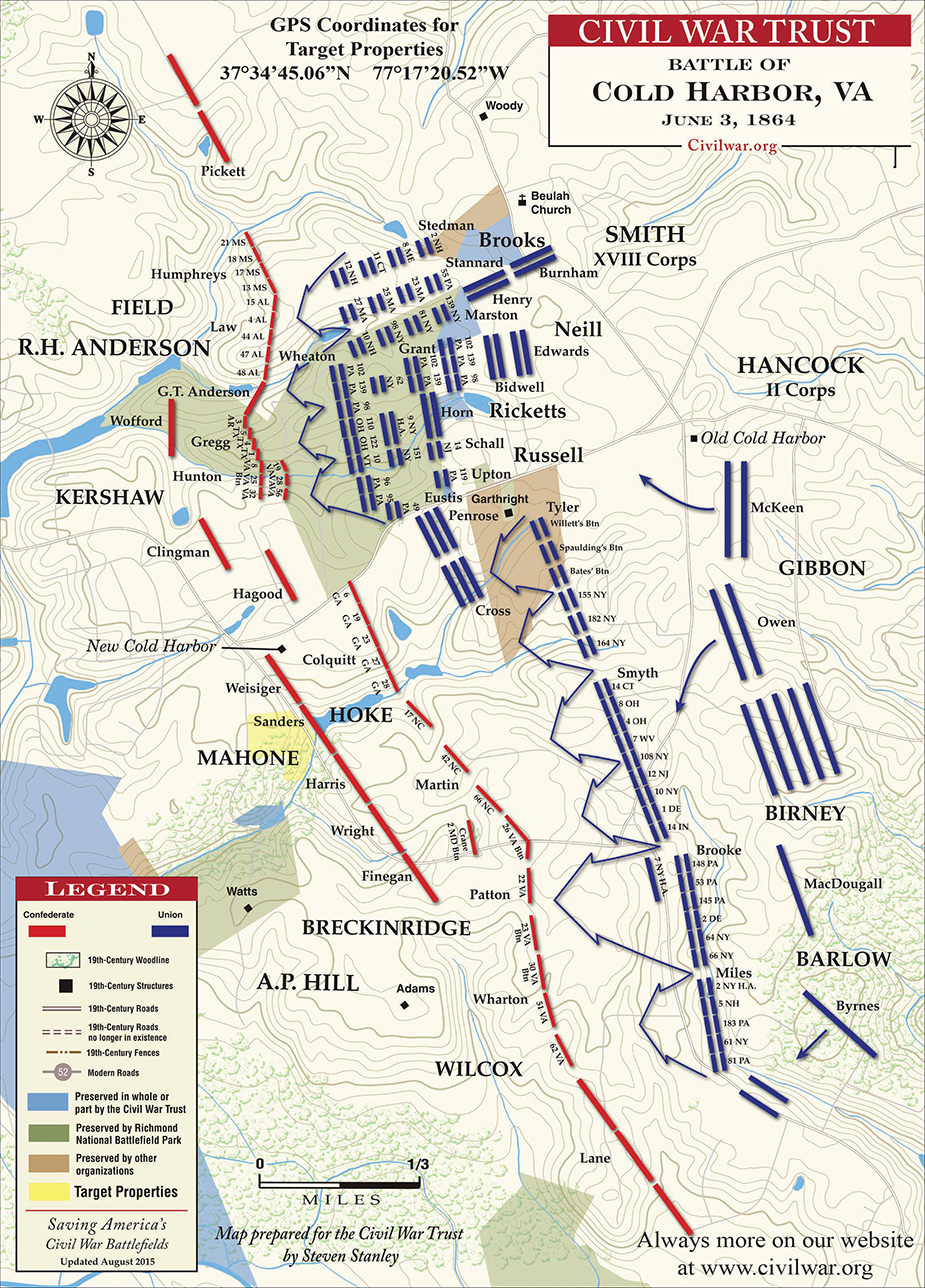
|
| Battle of Cold Harbor, June 3 |
At 4:30 a.m. on June 3, the three Union corps began to advance through
a thick ground fog. Massive fire from the Confederate lines quickly caused heavy casualties, and the survivors were pinned
down. The most effective performance of the day was on the Union left flank, where Hancock's corps was able to break through
a portion of Breckinridge's front line and drive those defenders out of their entrenchments in hand-to-hand fighting. However,
nearby Confederate artillery turned the entrenchments into a death trap for the Federals. Breckinridge's reserves counterattacked
these men from the division of Brig. Gen. Francis C. Barlow and drove them off. Hancock's other advanced division, under Brig.
Gen. John Gibbon, became disordered in swampy ground and could not advance through the heavy Confederate fire. One of Gibbon's
men, complaining of a lack of reconnaissance, wrote, "We felt it was murder, not war, or at best a very serious mistake had
been made."
In the center, Wright's corps
was pinned down by the heavy fire and made little effort to advance further, still recovering from their costly charge on
June 1. On the Union right, Smith's men advanced through unfavorable terrain and were channeled into two ravines. When they
emerged in front of the Confederate line, rifle and artillery fire mowed them down. The artillery fire against Smith's corps
was heavier than might have been expected because Warren's V Corps to his right was reluctant to advance and the Confederate
gunners in Warren's sector concentrated on Smith's men instead. The only activity on the northern end of the field was by
Burnside's IX Corps, facing Jubal Early. He launched a powerful assault at 6 a.m. that overran the Confederate skirmishers
but mistakenly thought he had pierced the first line of earthworks and halted his corps to regroup before moving on, which
he planned for that afternoon.
At 7 a.m. Grant advised Meade to vigorously exploit any successful part
of the assault. Meade ordered his three corps commanders on the left to assault at once, without regard to the movements of
their neighboring corps. But all had had enough. Hancock advised against the move. Smith, calling a repetition of the attack
a "wanton waste of life," refused to advance again. Wright's men increased their rifle fire but stayed in place. By 12:30
p.m. Grant conceded that his army was done. He wrote to Meade, "The opinion of the corps commanders not being sanguine of
success in case an assault is ordered, you may direct a suspension of further advance for the present." Estimates of casualties
that morning are from 3,000 to 7,000 on the Union side, no more than 1,500 on the Confederate.
Grant and Meade launched no more attacks on the Confederate defenses at
Cold Harbor. Although Grant wired Washington that he had "gained no decisive advantage" and that his "losses were not severe,"
he wrote in his Personal Memoirs that he regretted for the rest of his life the decision to send in his men. The two opposing
armies faced each other for nine days of trench warfare, in some places only yards apart. The trenches were hot, dusty, and
miserable, but conditions were worse between the lines, where thousands of wounded Federal soldiers suffered horribly without
food, water, or medical assistance. Grant was reluctant to ask for a formal truce that would allow him to recover his wounded
because that would be an acknowledgment he had lost the battle. He and Lee traded notes across the lines from June 5 to June
7 without coming to an agreement, and when Grant formally requested a two-hour cessation of hostilities, it was too late for
most of the unfortunate wounded, who were now bloated corpses. Grant was widely criticized in the Northern press for this
lapse of judgment.
| Waud drawing of the Battle of Cold Harbor |
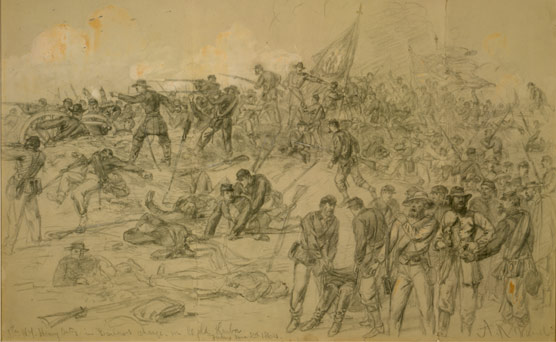
|
| Battle of Cold Harbor |
| Battle of Cold Harbor Marker |
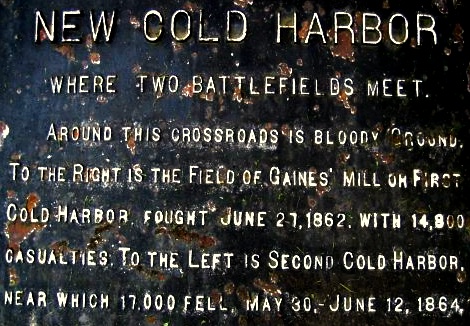
|
| Battle of Cold Harbor Marker |
| Civil War Battle of Cold Harbor |
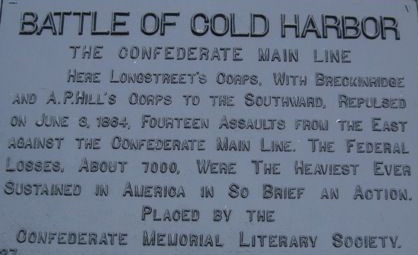
|
| Battle of Cold Harbor, Virginia |
(Right) Battle of Cold Harbor Historical Marker. The Confederate
Main Line. Inscription: "Here Longstreet's corps , with Breckinridge and A. P. Hill's corps to the southward, repulsed on
June 3, 1864, fourteen assaults from the east against the confederate main line. The Federal losses, about 7,000, were the
heaviest ever sustained in America in so brief an action." See also Cold Harbor National Cemetery and Ten Bloodiest and Costliest Battles of the American Civil War.
Chronology
May 31
After sparring along the Totopotomoy northeast of Richmond, Grant ordered
Maj. Gen. Philip Sheridan's cavalry to move south and capture the crossroads at Old Cold Harbor. Arriving near the intersection,
the Union force ran into Major General Fitzhugh Lee's Confederate horsemen. A sharp contest ensued, soon joined by Confederate
infantry under Brig. Gen. Thomas Clingman of Maj. Gen. Robert Hoke's division. After a short battle, Union cavalry drove
the Confederates beyond the crossroads. The Rebels would then started digging new positions a half mile to the southwest.
The cavalry forces that had fought at Old Church continued to face each
other on May 31. Lee sent a cavalry division under Maj. Gen. Fitzhugh Lee to reinforce Brig. Gen. Matthew Butler and secure
the crossroads at Old Cold Harbor. As Union Brig. Gen. Alfred T. A. Torbert increased pressure on the Confederates, Robert
E. Lee ordered Anderson's First Corps to shift right from Totopotomoy Creek to support the cavalry. The lead brigade of Hoke's
division also reached the crossroads to join Butler and Fitzhugh Lee. At 4 p.m. Torbert and elements of Brig. Gen. David McM.
Gregg's cavalry division drove the Confederates from the Old Cold Harbor crossroads and began to dig in. As more of Hoke's
and Anderson's men streamed in, Union cavalry commander Maj. Gen. Philip Sheridan became concerned and ordered Torbert to
pull back toward Old Church. Grant continued his interest in Old Cold
Harbor as an avenue for Smith's arrival and ordered Wright's VI Corps to move in that direction from his right flank on Totopotomoy
Creek. And he ordered Sheridan to return to the crossroads and secure it "at all hazards." Torbert returned at 1 a.m. and
was relieved to find that the Confederates had failed to notice his previous withdrawal.
June 1
Lee desired to retake Old Cold Harbor and sent Maj. Gen. Joseph Kershaw's troops to join Hoke in a morning assault. The effort was short and uncoordinated. Hoke failed to press the attack
and Sheridan's troopers, armed with Spencer repeating carbines, easily repulsed the assault. Grant, encouraged by this success,
ordered up reinforcements and planned his own attack for later the same day. If the Union frontal assault broke through the
Confederate defenses, it would place the Union army between Lee and Richmond. After a hot and dusty night march, Major General
Horatio Wright's VI Corps arrived and relieved Sheridan's cavalry, but Grant had to delay the attack Major General William
Smith's XVIII Corps, Army of the James, marching in the wrong direction under out-of-date orders, had to retrace its route
and arrived late in the afternoon. The Union attack would finally
begin at 5 p.m. Finding a fifty yard gap between Hoke's and Kershaw's divisions, Wright's veterans poured through, capturing
part of the Confederate lines. A Southern counterattack, however, sealed off
the break and ended the day's fighting. Confederate infantry strengthened their lines that night and waited for the battle
to begin next morning.
Robert E. Lee's plan for June 1 was to use his newly concentrated
infantry against the small cavalry forces at Old Cold Harbor. But his subordinates did not coordinate correctly. Anderson
did not integrate Hoke's division with his attack plan and left him with the understanding that he was not to assault until
the First Corps' attack was well underway, because the Union defenders were disorganized as well. Wright's VI Corps had not
moved out until after midnight and was on a 15 miles march. Smith's XVIII Corps had mistakenly been sent to New Castle Ferry
on the Pamunkey River, several miles away, and did not reach Old Cold Harbor in time to assist Torbert.
| Virginia Civil War Battles in 1864 |
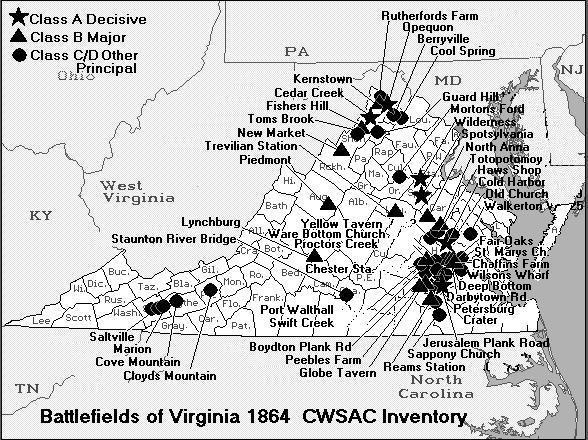
|
| Location of Battle of Cold Harbor |
| 10 miles separated Richmond from Cold Harbor |
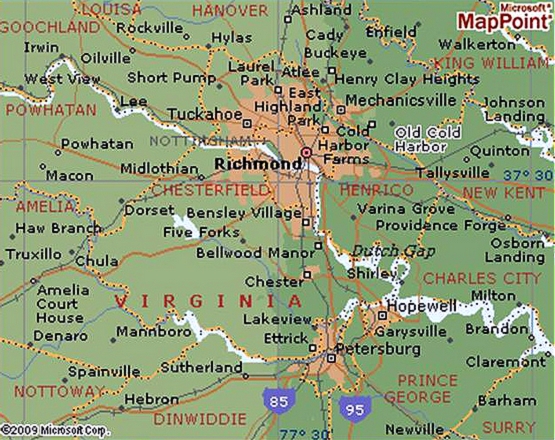
|
| Greater Cold Harbor Battlefield Map. Courtesy Microsoft Map Point. |
(Left) Map shows the crucial 10 mile distance between Old Cold Harbor and the Confederacy's most prized
city of Richmond.
Anderson led his attack with the brigade formerly commanded by veteran Brig. Gen. Joseph B. Kershaw, which
was now under a less experienced South Carolina politician, Col. Laurence M. Keitt. Keitt's men approached the entrenched
cavalry of Brig. Gen. Wesley Merritt. Armed with seven-shot Spencer repeating carbines, Merritt's men delivered heavy fire,
mortally wounding Keitt and destroying his brigade's cohesion. Hoke obeyed what he understood to be his orders and did not
join in the attack, which was quickly called back by Anderson.
By 9 a.m. Wright's lead elements arrived at the crossroads and began to extend and improve the entrenchments
started by the cavalrymen. Although Grant had intended for Wright to attack immediately, his men were exhausted from their
long march and they were unsure as to the strength of the enemy. Wright decided to wait until after Smith arrived, which occurred
in the afternoon, and the XVIII Corps men began to entrench on the right of the VI Corps. The Union cavalrymen retired to
the east.
For the upcoming attack, Meade was concerned that the corps of Wright and Smith would not be sufficient,
so he attempted to convince Warren to send reinforcements. He wrote to the V Corps commander, "Generals Wright and Smith will
attack this evening. It is very desirable you should join this attack, unless in your judgment it is impracticable." Warren
decided to send the division of Brig. Gen. Henry H. Lockwood, which began to march at 6 p.m., but no adequate reconnaissance
of the road network had been conducted and Lockwood was not able to reach the impending battle in time to make a difference.
Meade was also concerned about his left flank, which was not anchored on the Chickahominy and was potentially threatened by
Fitzhugh Lee's cavalry. He ordered Phil Sheridan to send scouting parties into the area, but Sheridan resisted, telling Meade
that it would be impossible to move his men before dark.
At 6:30 p.m. the attack that Grant had ordered for the morning finally began. Both Wright's and Smith's
corps moved forward. Wright's men made little progress south of the Mechanicsville Road, which connected New and Old Cold
Harbor, recoiling from heavy fire. North of the road, Brig. Gen. Emory Upton's brigade of Brig. Gen. David A. Russell's division
also encountered heavy fire from Brig. Gen. Thomas L. Clingman's brigade, "A sheet of flame, sudden as lightning, red as blood,
and so near that it seemed to singe the men's faces." Although Upton tried to rally his men forward, his brigade fell back
to its starting point.
To Upton's right, the brigade of Col. William S. Truex found a gap in the Confederate line, between the
brigades of Clingman and Brig. Gen. William T. Wofford, through a swampy, brush-filled ravine. As Truex's men charged through
the gap, Clingman swung two regiments around to face them, and Anderson sent in Brig. Gen. Eppa Hunton's brigade from his
corps reserve. Truex became surrounded on three sides and was forced to withdraw, although his men brought back hundreds of
Georgian prisoners with them.
While action continued on the southern end of the battlefield, the three corps of Hancock, Burnside, and
Warren were occupying a 5-mile line that stretched southeast to Bethesda Church, facing the Confederates under A.P. Hill,
Breckinridge, and Early. At the border between the IX and V Corps, the division of Maj. Gen. Thomas L. Crittenden, recently
transferred from the West following his poor performance in the Battle of Chickamauga, occupied a doglegged position with
an angle that was parallel to the Shady Grove Road, separated from the V Corps by a marsh known as Magnolia Swamp. Two divisions
of Early's Corps—Maj. Gen. Robert E. Rodes on the left, Maj. Gen. John B. Gordon on the right—used this area as
their avenue of approach for an attack that began at 7 p.m. Warren later described this attack as a "feeler", and despite
some initial successes, aided by the poor battle management of Crittenden, both Confederate probes were repulsed.
| Civil War Cold Harbor |
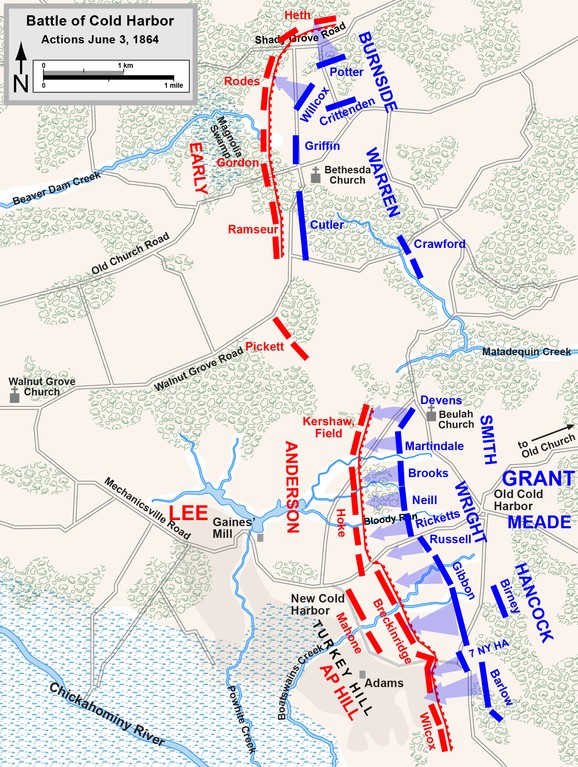
|
| Cold Harbor, June 3 |
| Battle of Cold Harbor |
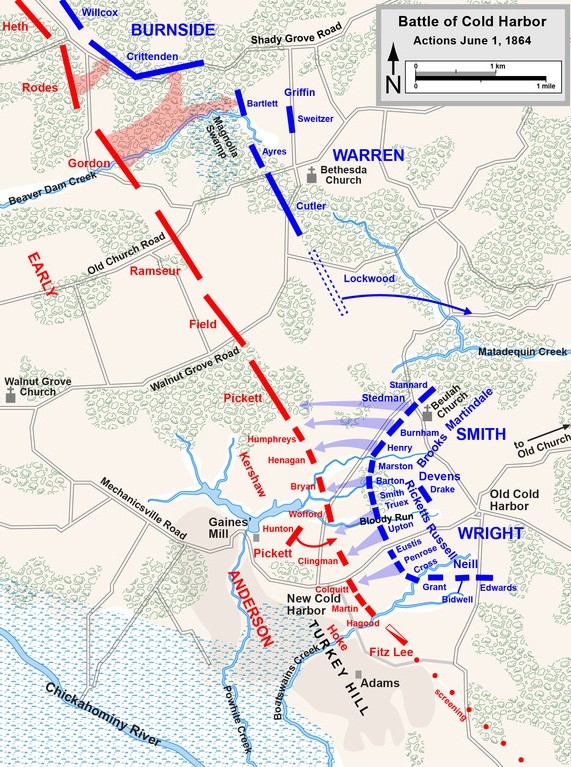
|
| Cold Harbor Battlefield, June 1 |
At this same
time, Warren's division under Lockwood had become lost wandering on unfamiliar farm roads. Despite having dispatched Lockwood
explicitly, the V Corps commander wrote to Meade, "In some unaccountable way, [Lockwood] took his whole division, without
my knowing it, away from the left of the line of battle, and turned up the dark 2 miles in my rear, and I have not yet got
him back. All this time the firing should have guided him at least. He is too incompetent, and too high rank leaves us no
subordinate place for him. I earnestly beg that he may at once be relieved of duty with this army." Meade relieved Lockwood
and replaced him with Brig. Gen. Samuel W. Crawford.
By dark, the fighting had petered out on both ends of the line. The Union assault had cost it 2,200 casualties,
versus about 1,800 for the Confederates, but some progress had been made. They almost broke the Confederate line, which was
now pinned in place with Union entrenchments being dug only yards away. Several of the generals, including Upton and Meade,
were furious at Grant for ordering an assault without proper reconnaissance.
June 2
Disappointed by the failed
attack, Grant planned another advance for 5 a.m. on June 2. He ordered Maj. Gen. Winfield Hancock's II Corps to march to the left of the VI Corps. Exhausted by a brutal night march
over narrow, dusty roads, the II Corps did not arrive until 6:30 a.m. Grant postponed the attack until 5 p.m. Later that day,
he approved a postponement until 4:30 a.m. of June 3 because of the spent condition of Hancock's men. The Union delays gave
Lee precious hours, time he used to strengthen his defenses. The Confederates had built simple trenches by daybreak of June
2. Under Lee's personal supervision, these works were expanded and strengthened throughout the day. By nightfall the Confederates
occupied an interlocking series of trenches with overlapping fields of fire. Reinforcements under Maj. Gen. John Breckinridge and Lt. Gen. Ambrose Hill arrived and fortified the Confederate right. Lee was
ready.
Although the June 1 attacks had been unsuccessful, Meade believed that an
attack early on June 2 could succeed if he was able to mass sufficient forces against an appropriate location. He and Grant
decided to attack Lee's right flank. Anderson's men had been heavily engaged there on June 1, and it seemed unlikely that
they had found the time to build substantial defenses. And if the attack succeeded, Lee's right would be driven back into
the Chickahominy River. Meade ordered Hancock's II Corps to shift southeast from Totopotomoy Creek and assume a position to
the left of Wright's VI Corps. Once Hancock was in position, Meade would attack on his left from Old Cold Harbor with three
Union corps in line, totaling 31,000 men: Hancock's II Corps, Wright's VI Corps, and Baldy Smith's XVIII Corps. Meade also
ordered Warren and Burnside to attack Lee's left flank in the morning "at all hazards," convinced that Lee was moving troops
from his left to fortify his right.
Hancock's men marched almost all night and arrived too worn-out for an immediate attack that morning. Grant
agreed to let the men rest and postponed the attack until 5 p.m., and then again until 4:30 a.m. on June 3. But Grant and
Meade did not give specific orders for the attack, leaving it up to the corps commanders to decide where they would hit the
Confederate lines and how they would coordinate with each other. No senior commander had reconnoitered the enemy position.
Baldy Smith wrote that he was "aghast at the reception of such an order, which proved conclusively the utter absence of any
military plan." He told his staff that the whole attack was, "simply an order to slaughter my best troops."
| Cold Harbor Civil War Battlefield Map |
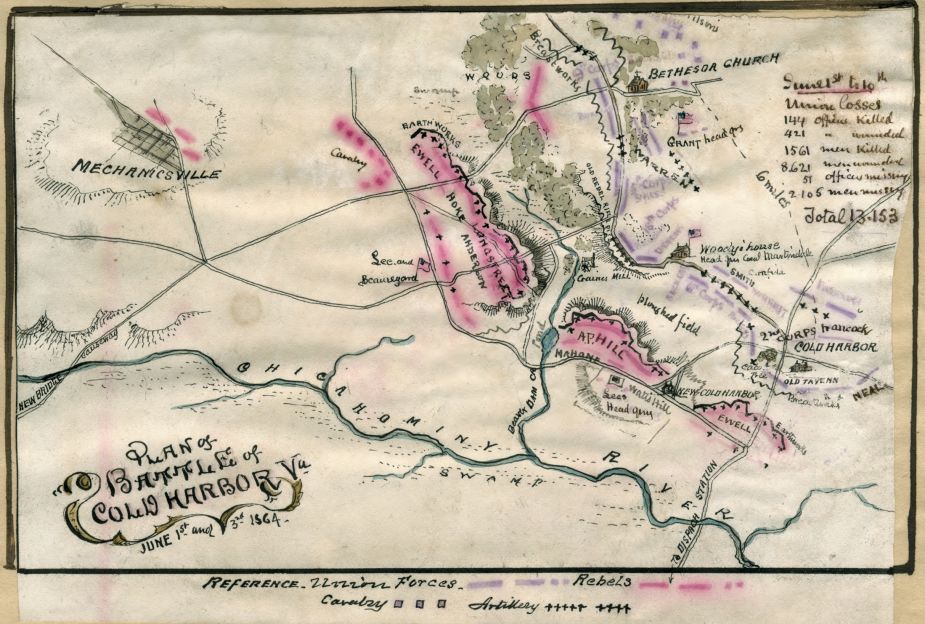
|
| Plan of Battle of Cold Harbor, VA, June 1st and 3rd. |
Robert E. Lee took advantage of the Union delays to bolster his defenses. When Hancock departed Totopotomoy
Creek, Lee was free to shift Breckenridge's division to his far right flank, where he would once again face Hancock. Breckinridge
drove a small Union force off Turkey Hill, which dominated the southern part of the battlefield. Lee also moved troops from
A.P. Hill's Third Corps, the divisions of Brig. Gens. William Mahone and Cadmus M. Wilcox, to support Breckinridge, and stationed
cavalry under Fitzhugh Lee to guard the army's right flank. The result was a curving line on low ridges, 7 miles long, with
the left flank anchored on Totopotomoy Creek, the right on the Chickahominy River, making any flanking moves impossible.
Lee's engineers used their time effectively and constructed the "most ingenious defensive configuration
the war had yet witnessed." Barricades of earth and logs were erected. Artillery was posted with converging fields of fire
on every avenue of approach, and stakes were driven into the ground to aid gunners' range estimates. A newspaper correspondent
wrote that the works were, "Intricate, zig-zagged lines within lines, lines protecting flanks of lines, lines built to enfilade
an opposing line, ... [It was] a maze and labyrinth of works within works." Heavy skirmish lines suppressed any ability of
the Union to determine the strength or exact positions of the Confederate entrenchments.
Although they did not know the details of their objectives, the Union soldiers who had survived the frontal
assaults at Spotsylvania Court House seemed to be in no doubt as to what they would be up against in the morning. Grant's
aide, Lt. Col. Horace Porter, wrote in his memoirs that he saw many men writing their names on papers that they pinned inside
their uniforms, so their bodies could be identified. (The accuracy of this story is disputed as Porter is the only source.)
One blood-spattered diary from a Union soldier found after the battle included a final entry: "June 3. Cold Harbor. I was
killed."
On the northern end of the battlefield, Warren's V Corps linked up with Burnside's IX Corps near Bethesda
Church. Early's Confederate Second Corps, on Lee's left flank, pushed forward and captured several of Warren's skirmishers.
Light fighting occurred throughout the night, having little effect on the main battle to come. Burnside at one point was advised
to attack Early's unprotected flank on Shady Grove Road, but he demurred.
June 3
At 4:30 on the morning of June 3 almost 50,000 Federal troops in the II,
VI and XVIII Corps launched a massive assault. The Confederate position, now well entrenched, proved too strong for the Union
troops. In less than an hour, thousands of Federal soldiers lay dead and dying between the lines. Pinned down by a tremendous
volume of Confederate infantry and artillery fire, Grant's men could neither advance nor retreat. With cups, plates, and bayonets,
they dug makeshift trenches. Later, when darkness fell, these trenches were joined and improved.
| Cold Harbor Historical Marker |
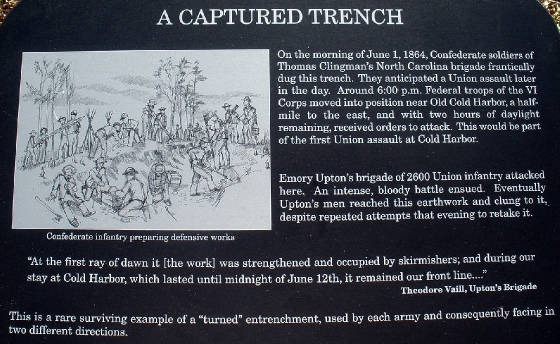
|
| Battle of Cold Harbor, June 1, 1864 |
At 4:30 a.m. on June 3, the three Union corps began to advance through a
thick ground fog. Massive fire from the Confederate lines quickly caused heavy casualties and the survivors were pinned down.
Although the results varied in different parts of the line, the overall repulse of the Union advance resulted in the most
lopsided casualties since the assault on Marye's Heights at the Battle of Fredericksburg in 1862.
The most effective performance of the day was on the Union left flank, where
Hancock's corps was able to break through a portion of Breckinridge's front line and drive those defenders out of their entrenchments
in hand-to-hand fighting. Several hundred prisoners and four guns were captured. However, nearby Confederate artillery was
brought to bear on the entrenchments, turning them into a death trap for the Federals. Breckinridge's reserves counterattacked
these men from the division of Brig. Gen. Francis C. Barlow and drove them off. Hancock's other advanced division, under Brig.
Gen. John Gibbon, became disordered in swampy ground and could not advance through the heavy Confederate fire, with two brigade
commanders (Cols. Peter A. Porter and H. Boyd McKeen) lost as casualties. One of Gibbon's men, complaining of a lack of reconnaissance,
wrote, "We felt it was murder, not war, or at best a very serious mistake had been made."
In the center, Wright's corps was pinned down by the heavy fire and made
little effort to advance further, still recovering from their costly charge on June 1. The normally aggressive Emory Upton
felt that further movement by his division was "impracticable." Confederate defenders in this part of the line were unaware
that a serious assault had been made against their position.
On the Union right, Smith's men advanced through unfavorable terrain
and were channeled into two ravines. When they emerged in front of the Confederate line, rifle and artillery fire mowed them
down. A Union officer wrote, "The men bent down as they pushed forward, as if trying, as they were, to breast a tempest, and
the files of men went down like rows of blocks or bricks pushed over by striking against one another." A Confederate described
the carnage of double-canister artillery fire as "deadly, bloody work." The artillery fire against Smith's corps was heavier
than might have been expected because Warren's V Corps to his right was reluctant to advance and the Confederate gunners in
Warren's sector concentrated on Smith's men instead.
The only activity on the northern end of the field was by Burnside's IX
Corps, facing Jubal Early. He launched a powerful assault at 6 a.m. that overran the Confederate skirmishers but mistakenly
thought he had pierced the first line of earthworks and halted his corps to regroup before moving on, which he planned for
that afternoon.
| Battle of Cold Harbor Battlefield, June 3, 1864 |
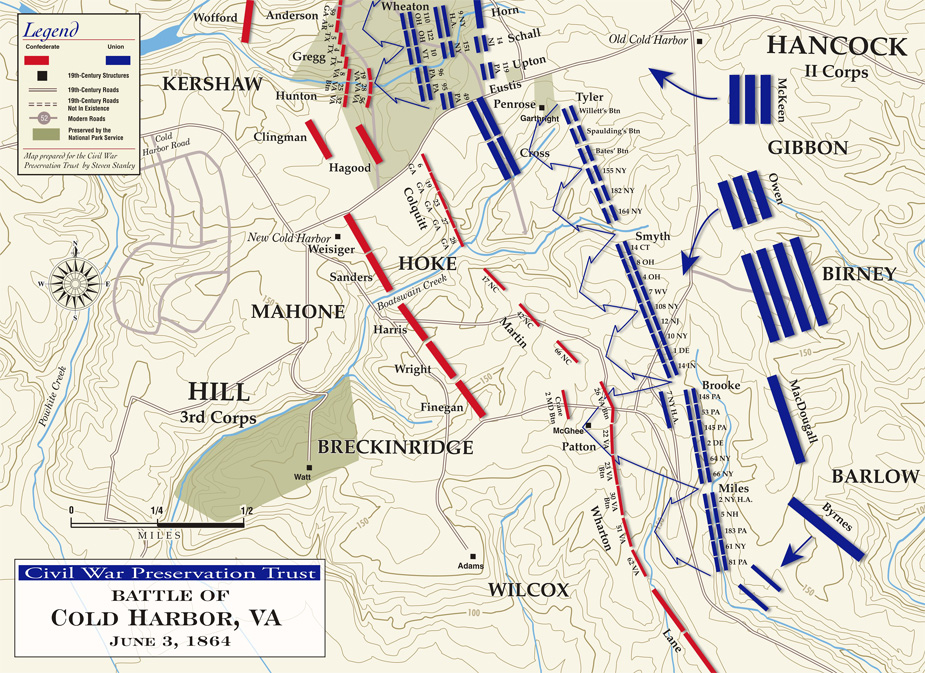
|
| Cold Harbor Battlefield, June 3, 1864 |
At 7 a.m. Grant advised Meade to vigorously exploit any successful part
of the assault. Meade ordered his three corps commanders on the left to assault at once, without regard to the movements of
their neighboring corps. But all had had enough. Hancock advised against the move. Smith, calling a repetition of the attack
a "wanton waste of life," refused to advance again. Wright's men increased their rifle fire but stayed in place. By 12:30
p.m. Grant conceded that his army was done. He wrote to Meade, "The opinion of the corps commanders not being sanguine of
success in case an assault is ordered, you may direct a suspension of further advance for the present." Union soldiers still
pinned down before the Confederate lines began entrenching, using cups and bayonets to dig, sometimes including bodies of
dead comrades as part of their improvised earthworks.
Meade inexplicably bragged to his wife the next day that he was in command
for the assault. But his performance had been poor. Despite orders from Grant that the corps commanders were to examine the
ground, their reconnaissance was lax and Meade failed to supervise them adequately, either before or during the attack. He
was able to motivate only about 20,000 of his men to attack—the II Corps and parts of the XVIII and IX—failing
to achieve the mass he knew he required to succeed. His men paid heavily for the poorly coordinated assault. Estimates of
casualties that morning are from 3,000 to 7,000 on the Union side, no more than 1,500 on the Confederate.
At 11 a.m. on June 3, the Confederate postmaster general, John H. Reagan,
arrived with a delegation from Richmond. He asked Robert E. Lee, "General, if the enemy breaks your line, what reserve have
you?" Lee provided an animated response: "Not a regiment, and that has been my condition ever since the fighting commenced
on the Rappahannock. If I shorten my lines to provide a reserve, he will turn me; if I weaken my lines to provide a reserve,
he will break them.
June 4-12
The great attack at Cold Harbor was over. Hundreds of wounded Federal soldiers remained on the battlefield
for four days as Grant and Lee negotiated a cease-fire. Few survived the ordeal. From June 4 to June 12,
both armies fortified their positions and settled into siege warfare. The days were filled with minor attacks, artillery duels
and sniping. With the Union defeat at Cold Harbor, Grant changed his overall strategy and abandoned further direct moves against
Richmond. On the night of June 12, Union forces withdrew and marched south towards the
James River. During the two week period along the Totopotomoy and at Cold Harbor, the Federal army lost 12,000 killed, wounded,
missing and captured while the Confederates suffered some 2,500 casualties. Grant's
next target was Petersburg and the railroads that provided needed supplies to the Confederate army. Cold Harbor proved to
be Lee's last major field victory and changed the course of the war from one of maneuver to one of entrenchment.
Grant and Meade launched no more attacks on the Confederate defenses at
Cold Harbor. Although Grant wired Washington that he had "gained no decisive advantage" and that his "losses were not severe,"
he wrote in his Personal Memoirs that he regretted for the rest of his life the decision to send in his men. The two opposing
armies faced each other for nine days of trench warfare, in some places only yards apart. Sharpshooters worked continuously,
killing many. Union artillery bombarded the Confederates with a battery of eight Coehorn mortars; the Confederates responded
by depressing the trail of a 24-pound howitzer and lobbing shells over the Union positions. Although there were no more large-scale
attacks, casualty figures for the entire battle were twice as large as from the June 3 assault alone.
| Civil War Battles Around Richmond |
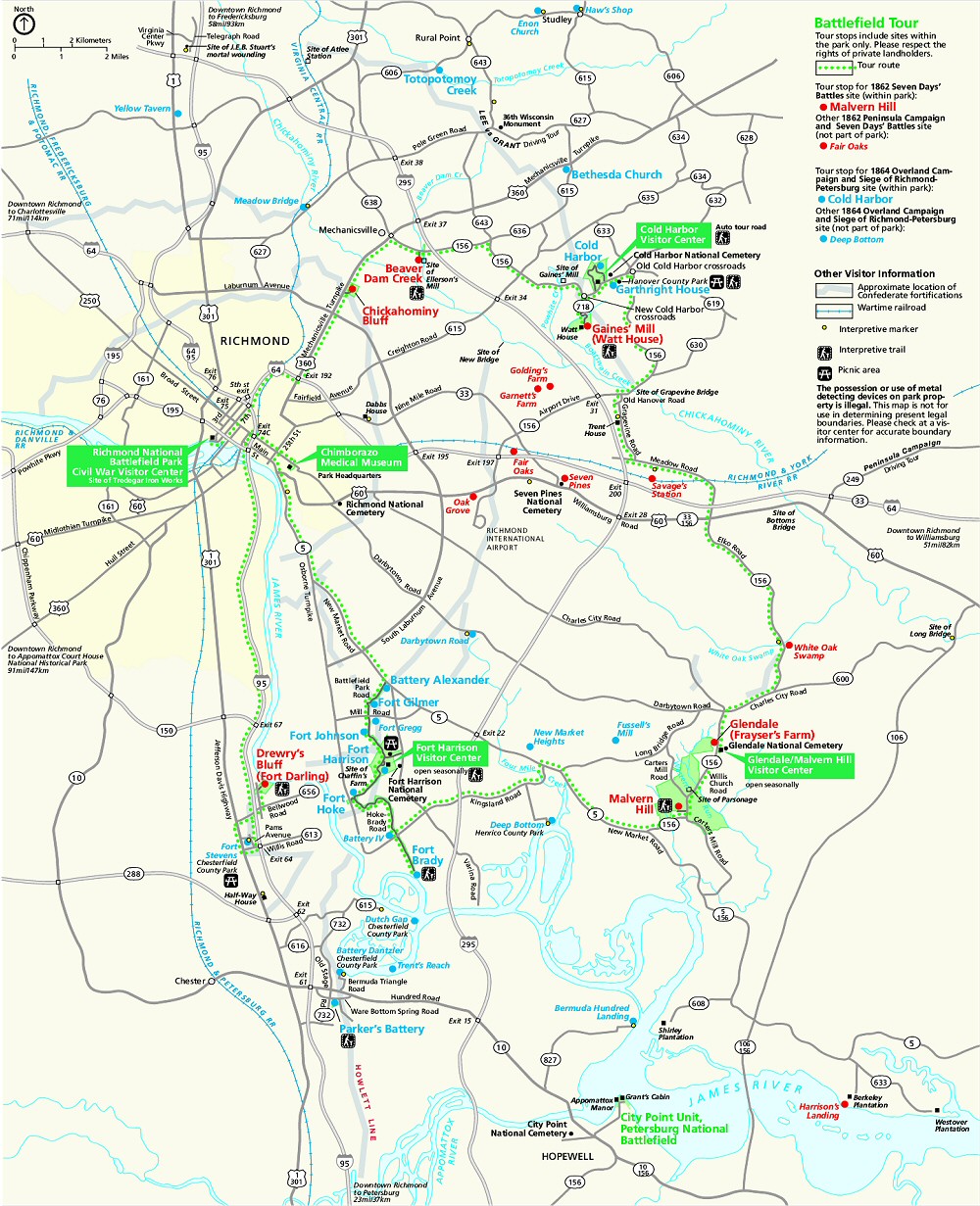
|
| Greater Richmond Civil War History |
(About) Map shows the numerous Civil War battles fought around Richmond. At the outbreak of
the American Civil War in 1861, the strategic location of the Tredegar Iron Works was one of the primary factors in the decision
to make Richmond the Capital of the Confederacy. The arsenal produced the 723 tons of armor plating that covered the CSS Virginia, the world’s first ironclad used in war, as well as much of the Confederates' heavy ordnance machinery.
The trenches were hot, dusty, and miserable, but conditions were worse between
the lines, where thousands of wounded Federal soldiers suffered horribly without food, water, or medical assistance. Grant
was reluctant to ask for a formal truce that would allow him to recover his wounded because that would be an acknowledgment
he had lost the battle. He and Lee traded notes across the lines from June 5 to 7 without coming to an agreement, and when
Grant formally requested a two-hour cessation of hostilities, it was too late for most of the unfortunate wounded, who were
now bloated corpses. Grant was widely criticized in the Northern press for this lapse of judgment.
On June 4 Grant tightened his lines by moving Burnside's corps behind Matadequin
Creek as a reserve and moving Warren leftward to connect with Smith, shortening his lines about 3 miles. On June 6 Early probed
Burnside's new position but could not advance through the impassable swamps.
Grant realized that, once again in the campaign, he was in a stalemate with
Lee and additional assaults were not the answer. He planned three actions to make some headway. First, in the Shenandoah Valley,
Maj. Gen. David Hunter was making progress against Confederate forces, and Grant hoped that by interdicting Lee's supplies,
the Confederate general would be forced to dispatch reinforcements to the Valley. Second, on June 7 Grant dispatched his cavalry
under Sheridan (the divisions of Brig. Gens. David McM. Gregg and Wesley Merritt) to destroy the Virginia Central Railroad
near Charlottesville. Third, he planned a stealthy operation to withdraw from Lee's front and move across the James River.
Lee reacted to the first two actions as Grant had hoped. He pulled Breckinridge's division from Cold Harbor and sent it toward
Lynchburg to parry Hunter. By June 12 he followed this by assigning Jubal Early permanent command of the Second Corps and
sending them to the Valley as well. And he sent two of his three cavalry divisions in pursuit of Sheridan, leading to the
Battle of Trevilian Station. However, despite anticipating that Grant might shift across the James, Lee was taken by surprise
when it occurred. On June 12 the Army of the Potomac finally disengaged to march southeast to cross the James and threaten
Petersburg, a crucial rail junction south of Richmond.
Aftermath: The Battle of Cold Harbor was the final
victory won by Lee's army during the war, and its most decisive in terms of casualties. Part of Lee's forces, however, won
the Battle of the Crater the following month, during the Siege of Petersburg, but this did not represent a general engagement between the armies. The Union
army, attempting the futile assault, lost 10,000 to 13,000 men over twelve days. The battle brought the toll in Union casualties
since the beginning of May to a total of more than 52,000, compared to 33,000 for Lee. Although the cost was horrible, Grant's
larger army finished the campaign with lower relative casualties than Lee's. See also Virginia Civil War History.
*Estimated Casualties
Casualty Estimates for the Battle of Cold Harbor
| Source |
Union |
Confederate |
| Killed |
Wounded |
Captured/
Missing |
Total |
Killed |
Wounded |
Captured/
Missing |
Total |
| National Park Service |
|
|
|
13,000 |
|
|
|
2,500 |
| Bonekemper, Victor, Not a Butcher |
1,844 |
9,077 |
1,816 |
12,737 |
83 |
3,380 |
1,132 |
4,595 |
| Eicher, Longest Night |
|
|
|
12,000 |
|
|
|
"few
thousand" |
| Fox, Regimental Losses |
1,844 |
9,077 |
1,816 |
12,737 |
|
|
|
|
| Rhea, Cold Harbor |
|
|
|
6,000
(June 3) |
|
|
|
1,500 |
| Smith, Grant |
1,769 |
6,752 |
1,537 |
10,058 |
|
|
|
|
Estimates vary as to the casualties at Cold Harbor. The above table summarizes
estimates from a variety of popular sources.
Some contemporary authors (Catton,
Esposito, Foote, McPherson, Smith) estimate the casualties for the major assault on June 3 and all agree on approximately
7,000 total Union casualties, 1,500 Confederate. Gordon Rhea, considered the preeminent modern historian of Grant's Overland
Campaign, has examined casualty lists in detail and has published a contrarian view in his 2002 book, Cold Harbor.
For the morning assault on June 3, he can account for only 3,500 to 4,000 Union killed, wounded, and missing, and estimates
that for the entire day the Union suffered about 6,000 casualties, compared to Lee's 1,000 to 1,500.
The battle caused a rise in anti-war sentiment in the Northern states and it lowered the morale of the Union
soldiers. Grant became known as "The Butcher" or "fumbling butcher" for his poor decisions. But the campaign had
served Grant's purpose—as ill-advised as his attack on Cold Harbor was, Lee had lost the initiative and was forced to
devote his attention to the defense of Richmond and Petersburg. He beat Grant to Petersburg, barely, but spent the remainder
of the war (save its final week) defending Richmond behind a fortified trench line. Although Southerners realized their situation
was desperate, they hoped that Lee's stubborn (and bloody) resistance would have political repercussions by causing Abraham
Lincoln to lose the 1864 presidential election to a more peace-friendly candidate. The taking of Atlanta in September dashed
these hopes, and the end of the Confederacy was just a matter of time.
| Cold Harbor Civil War History |
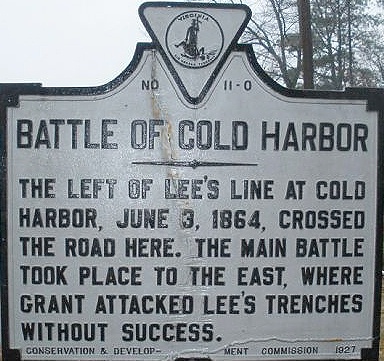
|
| Battle of Cold Harbor |
| Cold Harbor Battlefield Marker |
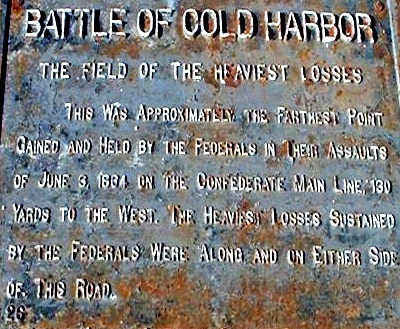
|
| Battle of Cold Harbor |
Analysis: The Battle of Cold Harbor was part of the
Grant's Overland Campaign and fought from May 31 to June 12, 1864, with the most significant fighting occurring on June 3. It was one of the final
battles of Union Lt. Gen. Ulysses S. Grant's Overland Campaign during the American Civil War, and is remembered as one of
American history's bloodiest, most lopsided battles. Thousands of Union soldiers were killed or wounded in a series of hopeless
frontal assaults against the fortified positions of Confederate Gen. Robert E. Lee's army.
On May 31, as Grant's army once again swung around the right flank of Lee's
army, Union cavalry seized the crossroads of Old Cold Harbor, about 10 miles northeast of the Confederate capital of Richmond,
Virginia, holding it against Confederate attacks until the Union infantry arrived. Both Grant and Lee, whose armies had suffered
enormous casualties in the Overland Campaign, received reinforcements.
On the morning of June 1, 1864, Confederate soldiers of Brig. Gen. Thomas
L. Clingman’s North Carolina brigade had frantically dug a trench while anticipating a Union assault later in the day.
Around 6:00 p.m., Federal troops of the VI Corps moved into position near Old Cold Harbor, a half-mile to the east, and with
two hours of daylight remaining, received orders to attack. This would be part of the first Union assault at Cold Harbor. Colonel
Elisha S. Kellogg and the 2nd Connecticut Heavy Artillery, meanwhile, engaged the center of Clingman's North Carolinians,
and with merely 30 feet separating the opposing commanders, the Confederate general eyed Colonel Kellogg as each
were shouting and barking commands to their men.
"A tall and uncommonly fine looking officer in the front rank of the
enemy's column, looking me directly in the face, took off his cap and cheered his men with words I could not catch." Brig. Gen. Clingman referring to Colonel Kellogg during the action of Cold Harbor. According
to the former US senator, Kellogg had been about ten paces directly to his front, when, within moments of exhorting his troops,
the Union officer received two bullets to the head before falling dead. During the
evening of June 1, the Union VI Corps and XVIII Corps arrived and assaulted the Confederate works to the west of the crossroads
with some success.
On June 2, the remainder of both armies arrived and the Confederates built
an elaborate series of fortifications 7 miles long. At dawn on June 3, three Union corps attacked the Confederate works on
the southern end of the line and were easily repulsed with heavy casualties. Attempts to assault the northern end of the line
and to resume the assaults were also unsuccessful.
Lt. Gen. Grant had continued to double down on his reckless assaults against the well-entrenched Rebel
lines in hopes of some quick victory. The impatient commander had committed to numerous ill-fated attempts at breaking
and exploiting the stubborn Confederate lines only to be repulsed each time with unnecessary losses. It was not the first
time that Grant had made such reckless assaults.
In July 1863 at Vicksburg, for example, the Union commander had also
unwisely pressed the Confederates only to be repulsed each time with heavy casualties. But unlike Vicksburg which capitulated on
July 4 after a siege, Grant would lick his wounds, bemoan his own actions, and push his behemoth of an army in pursuit
of Lee in hopes of forcing the Virginian's surrender. And although the Union army could replenish its thinned ranks, the Northern
papers and politicians wouldn't be so forgiving of the Ohioan who they now referred to as The Butcher. Grant needed
results however, and as Lee began to move his command toward Richmond and Petersburg, The Butcher would have his opportunity. Near the Confederate capital, Grant
would repeat the lessons that he had learned during the Battle of Vicksburg, but this time Lee wouldn't so fortunate.
Grant
said of the battle in his memoirs, "I have always regretted that the last assault at Cold Harbor was ever made. ... No advantage
whatever was gained to compensate for the heavy loss we sustained." The armies confronted each other on these lines until
the night of June 12, when Grant again advanced by his left flank, marching to the James River. It was an impressive
defensive victory for Lee, but it was his last in the war. In the final stage, he alternated between digging into the trenches
at Petersburg and fleeing westward across Virginia.
(Sources and related reading below.)
Recommended Reading: Cold Harbor: Grant and
Lee, May 26-June 3, 1864, by Gordon C. Rhea (Hardcover). Description: In his gripping volume on the spring 1864 Overland campaign--which pitted Ulysses S. Grant
against Robert E. Lee for the first time in the Civil War--Gordon Rhea vividly re-creates the battles and maneuvers from the
North Anna stalemate through the Cold Harbor offensive. Rhea's tenacious research elicits
stunning new facts from the records of a phase oddly ignored or mythologized by historians. The Cold Harbor of these pages
differs sharply from the Cold Harbor of popular lore. We see Grant, in one of his most brilliant
moves, pull his army across the North Anna
River and steal a march on Lee. In response, Lee sets up a strong defensive
line along Totopotomoy Creek, and the battles spark across woods and fields northeast of Richmond.
Continued below…
Their back
to the Chickahominy River and on their last legs,
the rebel troops defiantly face an army-wide assault ordered by Grant that extends over three hellish days. Rhea gives a surprising
new interpretation of the famous battle that left seven thousand Union casualties and only fifteen hundred Confederate dead
or wounded. Here, Grant is not a callous butcher, and Lee does not wage a perfect fight. Every imaginable primary source has
been exhausted to unravel the strategies, mistakes, gambles, and problems with subordinates that preoccupied two exquisitely
matched minds. In COLD HARBOR,
Rhea separates fact from fiction in a charged, evocative narrative. He leaves readers under a moonless sky, Grant pondering
the eastward course of the James River fifteen miles south of the encamped armies. About
the Author: Gordon Rhea is the author of three previous books, a winner of the Fletcher Pratt Literary Award, a frequent lecturer
throughout the country on military history, and a practicing attorney.
Advance to:
Recommended Reading: Not War
But Murder: Cold Harbor 1864. Library Journal: On June 3, 1864, the Union Second, Sixth, and Eighteenth Corps assaulted Confederate breastworks
at Cold Harbor outside Richmond, VA.
The resulting bloodbath amounted to U.S. Grant's worst defeat and "Bobby" Lee's final great victory. In his latest book, native
Virginian and Baltimore Sun correspondent Furgurson (Chancellorsville, 1863) vividly retells
the well-known story of how the friction between Grant and his insecure direct subordinate, George Meade, poisoned the Army
of the Potomac's whole chain of command. Continued below…
By contrast,
he depicts Lee as a commander beset by poor health and impossible logistical problems who brilliantly deployed his meager
forces and soundly thrashed his overconfident adversary, thereby saving the rebel capital and extending an unwinnable war
by nearly a year. The book is rich in word pictures and engaging anecdotes. Furgurson considers the wounded that were left
to suffer with the dead between the lines while Lee and Grant quibble over protocols of recovery; the disastrous affect of
poor maps and impassable terrain on the Federal assault; and Grant's immediate need to bring Lincoln a battlefield victory
before the 1864 presidential election. Furgurson's contribution is his evocative retelling of a great American military tragedy.
Recommended Reading: Bloody Roads
South: The Wilderness to Cold Harbor, May-June 1864, by Noah Andre Trudeau.
Description: "Nobody has brought together in one volume
so many eyewitness accounts from both sides."-Civil War History Winner of the Fletcher Pratt Award. In this authoritative
chronicle of the great 1864 Overland Campaign in Virginia, Noah Andre Trudeau vividly re-creates the brutal forty days that
marked the beginning of the end of the Civil War. In riveting detail Trudeau traces the carnage from the initial battles in
Virginia's Wilderness to the gruesome hand-to-hand combat at Spotsylvania's "Bloody Angle,"
to the ingenious trap laid by Lee at the North Anna
River, to the killing ground of Cold Harbor. Through
fascinating eyewitness accounts, he relates the human stories behind this epic saga. Continued below…
Common soldiers
struggle to find the words to describe the agony of their comrades, incredible tales of individual valor, their own mortality.
Also recounting their experiences are the women who nursed these soldiers and black troops who were getting their first taste
of battle. The raw vitality of battle sketches by Edwin Forbes and Alfred R. Waud complement the words of the participants.
PRAISE FOR THE BOOK: "Bloody Roads South is a powerful and eloquent narrative of the costliest, most violent campaign of the
Civil War. Grant vs. Lee in the Wilderness, at Spotsylvania, and at Cold Harbor has never been told better."-Stephen W. Sears, author of The Landscape Turned
Red. About the Author: Noah Andre Trudeau is an executive producer for cultural programs at National Public Radio in Washington, D.C. He is the author of
Out of the Storm: The End of the Civil War, April-June 1865 and The Last Citadel: Petersburg,
Virginia, June 1864-April 1865.
Recommended
Reading: Trench Warfare under Grant and Lee: Field Fortifications in the Overland Campaign
(Civil War America) (Hardcover) (The University of North Carolina Press) (September
5, 2007). Description: In the study of field fortifications
in the Civil War that began with Field Armies and Fortifications in the Civil War, Hess turns to the 1864 Overland campaign
to cover battles from the Wilderness to Cold Harbor. Continued below...
Drawing on
meticulous research in primary sources and careful examination of trench remnants at the Wilderness, Spotsylvania, North Anna,
Cold Harbor, and Bermuda Hundred, Hess describes Union and Confederate earthworks and how Grant and Lee used them in this new era of field
entrenchments.
Recommended Reading: Field Armies and Fortifications in the Civil War: The Eastern Campaigns,
1861-1864 (Civil War America)
(Hardcover). Description: The eastern campaigns of
the Civil War involved the widespread use of field fortifications, from Big Bethel and the Peninsula to Chancellorsville,
Gettysburg, Charleston, and
Mine Run. While many of these fortifications were meant to last only as long as the battle, Earl J. Hess argues that their
history is deeply significant. The Civil War saw more use of fieldworks than did any previous conflict in Western history.
Hess studies the use of fortifications by tracing the campaigns of the Army of the Potomac
and the Army of Northern Virginia from April 1861 to April 1864. Continued below...
He considers
the role of field fortifications in the defense of cities, river crossings, and railroads and in numerous battles. Blending
technical aspects of construction with operational history, Hess demonstrates the crucial role these earthworks played in
the success or failure of field armies. He also argues that the development of trench warfare in 1864 resulted from the shock
of battle and the continued presence of the enemy within striking distance, not simply from the use of the rifle-musket, as
historians have previously asserted. Based on fieldwork at 300 battle sites and extensive research in official reports, letters,
diaries, and archaeological studies, this book should become an indispensable reference for Civil War historians.
Recommended
Reading: The Battlefield of Cold Harbor, Hanover County, Virginia, 1864
(Map). Review: The site of Robert E. Lee and his Army
of Northern Virginia's last Civil War Victory is one of astonishment, battlefield courage, and horrific carnage… This
work includes the most complete, accurate and detailed maps of the battle of Cold Harbor
ever published. Watercolor and colored pencil map showing farms, mills, entrenchments, watercourses, woods, fields and residences
are all meticulously detailed and scaled to perfection. Continued below...
The reverse side includes an account of Union mapping at Cold Harbor; full
color reproduction of the Army of the Potomac’s Overland Campaign theater map; and photographs of two prominent Union
topographical engineers, W. H. Paine and W.A. Roebling. A welcome addition to every Civil War buff’s library as well
as the individual that appreciates detailed topographical maps. FIVE STARS.
Sources: National Park Service; Official Records of the Union and Confederate
Armies; Richmond National Battlefield Park; Bonekemper, Edward H., III, A Victor, Not a Butcher: Ulysses S. Grant's Overlooked
Military Genius, Regnery, 2004; Catton, Bruce, Grant Takes Command, Little, Brown, 1968; Eicher, David J., The Longest Night:
A Military History of the Civil War, Simon & Schuster, 2001; Esposito, Vincent J., West Point Atlas of American Wars,
Frederick A. Praeger, 1959; Foote, Shelby, The Civil War, A Narrative: Red River to Appomattox, Random House, 1974; Fox, William
F.: Regimental Losses in the American Civil War, Albany Publishing, 1889; Grant, Ulysses S., Personal Memoirs of U. S. Grant,
Charles L. Webster & Company, 1885–86; Jaynes, Gregory, and the Editors of Time-Life Books, The Killing Ground:
Wilderness to Cold Harbor, Time-Life Books, 1986; McPherson, James M., Battle Cry of Freedom: The Civil War Era (Oxford History
of the United States), Oxford University Press, 1988; Rhea, Gordon C., The Battle of Cold Harbor, National Park Service Civil
War Series, Eastern National, 2001; Rhea, Gordon C., To the North Anna River: Grant and Lee, May 13–25, 1864, Louisiana
State University Press, 2000; Rhea, Gordon C., Cold Harbor: Grant and Lee, May 26 – June 3, 1864, Louisiana State University
Press, 2002; Smith, Jean Edward, Grant, Simon and Shuster, 2001; Library of Congress; MicrosoftMapPoint.com; Microsoft Virtual
Earth; National Archives; civilwar.org (CWPT); Civil War Sites Advisory Commission (CWSAC).

|

